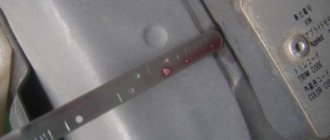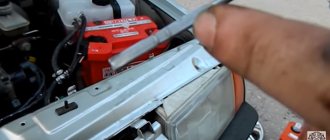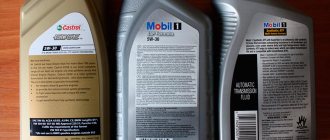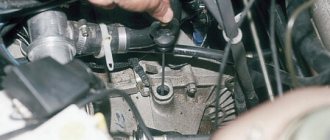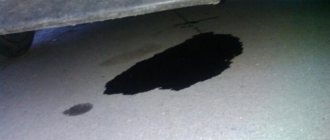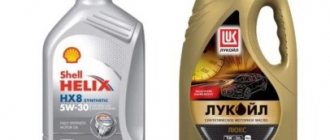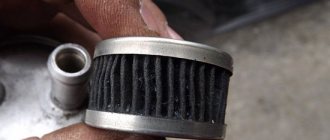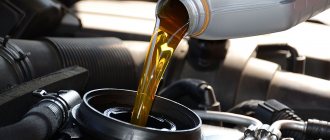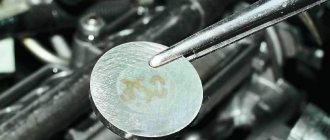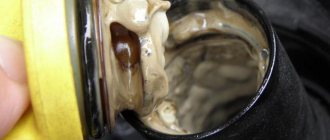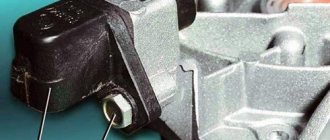A gearbox, also known as a transmission, a gearbox, a gearbox, a gearbox (gearbox) is a gear unit that finds its application in various types of industrial mechanisms (such as machine tools) and various transmissions in many mechanical vehicles.
The gearbox of a vehicle is designed to vary the torque and frequency at the drive wheels within the widest range of the potential supply of the vehicle's engine. Often, the above thesis applies to those internal combustion engines that have a very small amount of adaptability in their arsenal.
- 1. Diagnostics. What to look for when performing maintenance
- 2. Traditional gearbox malfunctions
Such vehicles that operate with electric engines (trolleybus, tram, electric car) and steam engines have a very high level of adaptability. In this case, parabolic (electric motors with constant voltage and current supply) and hyperbolic (steam vehicles) thrust characteristics are often put into operation without a variable gearbox.
In addition, the gearbox provides the potential ability to move a ground vehicle in reverse, as well as a fairly long disconnection from the engine propulsion, when directly starting the engine and its partial and at the same time full operation in parking lots.
In various types of machine tools, including metal-cutting ones, variable gearboxes are used to ensure optimal possible cutting conditions. In this way, the rotation speed of the workpiece or the cutting tool itself is adjusted. For car enthusiasts, this aspect is also quite important and significant, since it helps to fully understand and understand the principle of operation of the entire variable gearbox on various “tools” intended for human use.
The modern automotive world is developing at a very fast pace. It is human progress and subsequent innovations that give rise to more and more variations in the variety of types of variable gearboxes. Thus, today in automotive nature there are four types of variable transmissions:
– Manual gearbox. This type of gearbox is a cylindrical gearbox, which is multi-stage. This type of gearbox requires that gear shifting must be done manually.
– Automated gearbox. This transmission is designed to provide automatic gear selection, which is determined by the current driving conditions of the vehicle's gear ratio, which depends on many factors. That is, gear shifting occurs without direct driver intervention.
– Robotic gearbox. This type of box is a mechanical type of gearbox. But an important difference from simple mechanics is that the clutch release and gear shift functions are operated automatically.
– Variable gearbox – is a mechanical unit that is designed to transmit engine power to the drive wheels steplessly. It is widely used in Western European countries and the USA.
Why does car oil leak?
- Problems with seals. High pressure in the transmission constantly affects the seals, changing their condition. Wear of the oil seal leads to the appearance of a gap through which oil fluid leaks out of the automatic transmission/manual transmission. It is possible to get rid of gearbox oil leaks by replacing the oil seal. It is recommended to find out the cause of the increased compression and eliminate it.
- The input transmission shaft is subject to wear and backlash is formed. The gearbox needs to be dismantled and we need to think about how to fix the leak. Change the shaft, install a new lining. It all depends on the size of the backlash.
- Check all connection areas along the direction of the oil movement. Leaks can be detected by stains of lubricant. Replace the sealing element.
- Check that the cover of the hole through which the oil drains into the automatic transmission is tightly screwed on. Correct the special probe.
- A clogged breather can lead to increased compression in the unit. Having discovered this fact, dismantle the gearbox and clean the breather.
The breather must be clean
This list of probable causes of oil leakage is incomplete. Only the most common reasons are listed here.
see also
- How often do you change the automatic transmission oil?
- What kind of gearbox oil?
Which oil is best for shock absorbers?- Changing the oil in a Kia Sid box
- Which oil is best to use for frying?
- Which motor oil is best for Lifan x 60
- Which oil has the most omega 3
- Filling the gearbox with oil
- Changing diesel oil
- Changing engine oil
- Toyota Prius gearbox oil
Manual transmission: causes of major malfunctions and ways to eliminate them
Let's study in more detail the main types of malfunctions of both the box itself and the transmission mechanism, as well as providing an ambulance to the car in these cases.
Noise when the shift lever is in the neutral position of the gear selector. The reason for its appearance is most often due to increased wear of the bearings located in the drive shaft of the vehicle, as well as due to a critically low oil level in the gearbox itself. Also, the oil in the transmission may already be of too low a quality level.
This manifestation can be eliminated by checking the oil level and then replacing the worn bearing. If the transmission oil really hasn’t been changed for a long time, you should drain the old one, then replace it with a new one that will match the car. It is recommended to check old oil for the presence of metallic foreign particles and water, which is unacceptable.
If extraneous noise is heard when switching gears, then this may also be due to one of the reasons listed above, or deformation and increased wear of the locking element, as well as insufficient stability of the threaded connections, malfunction of the synchronizers and incomplete disengagement of the clutch.
Elimination of extraneous noise when gears are engaged:
- You should first check that the clutch is in full working order;
- If the synchronizers are faulty, measure the gap between the gears and the blocking ring located here, and also check the gears for damage;
Measuring the gap between gear and ring
- If there is insufficient oil, add it;
- If the quality of the transmission oil is poor, it must be completely replaced with a new one;
- Disengage the clutch completely and try to change gears again.
When noise is heard during operation of the gearbox, the cause may be high wear of gears, synchronizer couplings, bearings, as well as insufficient oil level in the transmission.
Elimination of noise can occur when adding oil if its level is below critical. This can be detected by the presence of traces of oil leakage from the transmission, and as a preventive measure the oil in a car of any modification should be changed every 10,000 km. It is also necessary to check the condition of the couplings for worn synchronizers and, if necessary, replace them.
This is what a worn gear with synchronizer looks like
If gear shifting is difficult, the drive cable may be loose or damaged, the clutch may not be completely disengaged, or the gear shift rod may be damaged or severely worn.
For better gear shifting in a manual transmission, you should first check whether the clutch is completely disengaged, check the oil level and its quality (if it is unsuitable for further use, replace it with a new one), and also check whether the gears are jamming and carry out a thorough inspection for damage in the system gear shift levers.
Don't forget to check the oil level
The gear shift lever is difficult to change position; you have to make some effort to change gears. The reason here is primarily the insufficient oil level in the transmission, because it is largely responsible for the smoothness of all movements associated with the transmission.
To eliminate this malfunction, you should check the oil level in the transmission and, if necessary, add it to the specified level.
In the case when the gears switch spontaneously, it is possible that the strength of the threaded connection in the fastening of the box itself has decreased, the drive cable has become stuck, or the wear of the gears has increased excessively, the wear of the synchronizer couplings, as well as the splined connections, rod or gear shift fork has reached the limit.
Cable-actuated gear selector
To eliminate this malfunction, it is necessary to clean the distance between the engine housing and the clutch lever located here from dirt, carefully inspect the threaded connections of the transmission, tighten them if necessary, and also, if the synchronizers or splined connections are excessively worn, completely replace them.
When oil begins to leak in the gearbox mechanism, it is visible even to the naked eye. The cause of leakage may be insufficient connection of the transmission itself or worn out seals. If necessary, the oil seals must be replaced, and the threaded connections must be checked and tightened.
Transmission oil leak
The recommendations listed above for troubleshooting both the gearbox itself and the transmission mechanism do not exclude, but rather oblige the owner to show his car to a specialist and carry out the necessary repair work in a workshop.
Malfunctions of any of the systems or individual components can occur in any machine. However, to prevent their occurrence, you should follow simple but quite effective rules regarding the operation of the car. Their simplicity does not mean ineffectiveness, because the rule that any disease is easier and faster to prevent than to treat later applies here.
Regarding the car, we can say that it is easier and also simpler to carry out a preventive inspection than to carry out expensive repairs later.
So, here are the basic tips for preventing major car malfunctions.
Why is oil dripping from under the car?
The most common cause is wear on the engine or pistons. During operation of the car, exhaust gases, bypassing the pipe, enter the crankcase, bypassing the piston rings. Accordingly, when the engine wears out, these gases create excessive pressure, as a result of which the oil is subjected to strong pressure and squeezed out of the container.
Why is oil dripping from under the car:
- Failure in the oil sensor area. This is a small device that shows how much oil is left in the container. To connect the measuring device to the system, several gaskets must be inserted. Failure of the gasket causes leaks and oil dripping.
- Oil filter . This usually occurs due to the filter weakening and space appearing between the bolts and the mesh. It is necessary to tighten the bolts further, sealing the filter, or replace it.
- Leaking seals. The main task of the oil seal is to seal, but it does not always cope with this task and often bursts or tears. It is for this reason that a small amount of liquid may leak out. The cost of the seals is low, however, you may need money for the work, since it is difficult to replace simple parts.
- Engine sump gasket leaking. It is necessary to replace the gaskets, or apply a sealant that is used in cars.
Flow
What causes gear oil to leak from a car's gearbox?
When the first signs of oil leakage appear from the housing of the unit that controls the engine torque, it is necessary to immediately identify the defective location. It can be found both under the hood of the car and under the bottom, having driven the vehicle onto an overpass or pit.
It is often impossible to instantly determine the place due to the “weakness” of which oil is leaking from the gearbox. The procedure is complicated by a variety of reasons and closed access to most vulnerable points of the unit. Transmission fluid leaks most often result from :
- wear of cuffs (oil seals);
- intensive wear of shaft surfaces in contact with sealing elements;
- unacceptable play of the gearbox input shaft;
- damage to the sealing layer between the body components of the assembly unit (between the rear housing, gearbox housing and clutch housing) or loosening of the bolts holding these elements together;
- wear of the sealing element of the speedometer drive shaft.
Transmission oil leaks can also occur for simpler reasons :
- the drain nut is not tightened with the torque required by the manufacturer;
- the measuring probe is not installed tightly;
- The reverse sensor is loose.
How can you tell what type of oil is dripping from under your car?
The worst situation is if grease drips through the crankshaft or camshaft seal. In fact, these parts are quite inexpensive, but to replace them you will have to go through most of the car. If you carry out repair work not yourself, but at a car service center, it will cost a pretty penny. If oil is oozing from almost all holes, then with 99% probability we can say that the situation requires serious intervention. These are clogged crankcases, or worn pistons and cylinders. In this case, you will have to completely disassemble the components and replace the motor.
The car engine system is created in such a way that its components are connected using a large number of seals and gaskets. Therefore, if one of them fails, you can observe oil leakage.
How to tell what kind of oil is dripping from under the car:
- At the initial stage, it is advisable to find out which node is faulty. To do this, you need to determine what kind of lubricant is flowing. They differ in their composition, so the origin of the liquid can be determined using a simple experiment.
- Find the leak and place a large napkin or cloth. It is necessary that a few drops fall on the fabric. Now you need to put the napkin in plain water. If it is motor oil, then the liquid that was on the fabric will sink to the bottom in the form of a large, large drop. If it is transmission fluid, it will rise to the surface in the form of greasy, oily drops. Thus, you can decide whether the transmission system or engine parts need repair.
Traces of oil
Diagnostics. What to look for when performing maintenance
Maintenance and repair support is a set of operations that are aimed at maintaining the serviceability and performance of vehicles and production equipment during storage, continuous operation and transportation. Thus, maintenance is a preventative measure. These operations are carried out systematically and forcibly through clearly established periods, which, in fact, include the required set of works.
In the modern world, the most common types of variable transmissions on most cars are automatic and manual. In turn, these two types have several subspecies. Our task is to examine in detail and to the smallest detail the question of what malfunctions of a manual transmission exist, to consider the main areas of potential breakdowns, and also what exactly you need to pay attention to during the maintenance process in order to find out what breakdowns are inherent in this box.
A very important point that all owners of an automatic variable transmission need to know. Most experts strongly recommend that owners of cars with this type of “box” not even try themselves as a mechanic and repair this gearbox themselves. In addition, it is strongly recommended to avoid repairing your own automatic transmission and using highly professional garage neighbors.
We should not forget that it often happens that an automatic variable transmission costs a third of the full price of the entire car. The gearbox repair itself depends entirely on the model and make of the car, as well as on the malfunction and breakdown that occurred in the gearbox of your own car.
Of course, within the confines of one article it will be impossible to fully describe all the smallest details and the entire technological process of repairing the gearbox yourself. It is important to note that for this purpose, in the automotive nature, there are instructions and repair manuals that are included with each specific make and model of car.
The deep and true purpose of this article is to determine the causes of breakdowns and malfunctions. In addition, it is necessary to clarify the point about what kind of repair of a manual transmission is needed and how much it will cost.
The very first thing that should be diagnosed while the car is moving is the smoothness and ease of engaging and shifting all gears. If there is a persistent feeling that gear shifting is difficult, you need to conduct a second technical inspection, which consists of a more thorough inspection of the variable gearbox itself.
During the second technical inspection, the gearbox fastenings that lead to the crankcase are checked and tightened, along with the bearing caps of the driven and intermediate shafts. If the need and need arises, then you need to change the oil in the gearbox housing.
An important point: the repair of the transmission of any car can be moved forward in time. This is possible provided that the first technical inspection of the gearbox is carried out correctly and on time. This inspection checks the oil level in the variable gearbox itself. This happens after 15-20 thousand km. mileage or once every year.
Oil spilled out of the box: reasons
The most common cause of leakage is the use of oil that is not suitable for the engine. That is why it is necessary to follow the labeling and adhere to the recommendations specified by the manufacturer. Too thin or thick oil can cause an increase in pressure in the system, so a significant amount of lubricant will be squeezed out through the seals.
Oil spilled out of the box, reasons:
- Excessive amount of lubricant . If the amount of fluid in the system increases, this causes excessive pressure and wear on the engine. Therefore, gaskets and sealing elements cannot withstand and begin to leak liquid.
- Long car downtime. If you do not use the car for a long time, the sealing elements may fail. If the car remains idle for a month, oil can drain into the crankcase, and seals, which are left without lubricant, dry out and crumble.
- Modern cars are equipped with a double crankcase ventilation system, so the first part operates under heavy loads and crankshaft speeds, and the second at idle. The equipment includes an oil deflector. This device prevents oil vapor from entering the engine. If this part becomes clogged, the operation is disrupted and the air filter and exhaust manifold are leaking. Therefore, during operation, the engine may begin to smoke.
- A ventilation valve that regulates exhaust gas pressure . If the device is open at idle, it closes smoothly with increasing speed. If the ventilation valve does not operate correctly, the mixture becomes too lean, causing engine interruptions.
- Sealing rubber tubes. Their main task is to remove large amounts of gases that enter the crankcase. If these ventilation elements become clogged with dirt, they contribute to the deterioration of the system's performance and become an impetus for breakage and failure of the gaskets. They begin to leak the oil mixture.
To check the ventilation system, you can perform a simple experiment. Remove the cap that is located near the neck where the oil is poured. Next, you need to attach a piece of cardboard or thick paper to this hole and start the car. The engine needs to start running. During operation of the system, the crankshaft rotation speed increases to 1000 rpm.
See what happens to a piece of cardboard. If, during the process of increasing speed, it is sucked in and fits tightly to the hole, this indicates a normal vacuum in the system and a decrease in pressure. When the pressure decreases, the cardboard seems to be pressed against the hole. If the ventilation does not work properly, then the required vacuum does not occur, and the cardboard does not stick to the hole in the drain cover.
Turbine leak
Determining the leak area
Oil leaks are fairly easy to detect. Puddles of grease under the car will indicate a problem better than any diagnosis. The size of the puddles will help determine the extent of the problem. Whether to resort to the services of a car service or not is up to you, but it is imperative to park the car on the overpass. Otherwise, you will not be able to accurately detect the leak area.
For prevention, look under your own car more often. A puddle of oil shouldn't be an unpleasant surprise in the middle of a trip.
The transmission is not designed for manual repair. Its malfunctions are usually eliminated radically: by replacing it with another unit. This needs to be done in a garage, and not in the middle of the road.
An oil leak from the gearbox must be eliminated immediately after it is discovered. Delaying the resolution of this issue leads to increased wear of spare parts and deterioration of the condition of the unit.
Simple factors
Circumstances of negligence and incompetence - both of auto mechanics and the owner of the car - can be easily eliminated. Among them:
- loose nut on the drain. He made it through - and off he went;
- The reverse sensor is loosely screwed in. The recommendations are the same;
- The dipstick for measuring the oil level is not inserted tightly (or crookedly, which is worse). Hammered it in tighter, adjusted it - job done;
- oil overflow. Generosity is not always good, and a new driver must learn this. It says “maximum”, which means stop. Excess oil will still have to be drained, and this, again, is a loss of money.
However, if you come across such a simple option, you can start to rejoice. Other reasons cannot be dealt with so easily.
Types of faults in manual transmissions of cars
The internal structure of the mechanical gear shift mechanism has its own characteristics, and its malfunctions can be divided into both breakdowns of the box itself and malfunctions of the transmission mechanism.
In order to be able to restore the car’s operation if any type of malfunction occurs, you should detect them in time and know the basic techniques for eliminating them. This is especially important if the breakdown occurred on the highway, on the road - then it will be important to resume the operation of the car until a visit to a repair specialist.
Let us list the main manifestations of malfunctions.
How to detect a malfunction?
The most common manifestations of malfunctions in the operation of manual transmissions include the following:
- The occurrence of extraneous noise when the handle is positioned in neutral;
- Noises when turned on, as well as when starting work;
- Difficulty when changing gears;
- The gear is switched off without affecting the shift lever;
- There is oil leakage from the transmission.
On a note
Please note! The internal cavity of the gearbox of any car is necessarily connected to the atmosphere through an ordinary small-diameter tube, called a breather . Due to clogging of the ventilation channel, the air expanded as a result of heating the oil is not removed and begins to create additional pressure on the oil, leading to its leakage through the seals, and in more advanced cases, to squeezing out the sealing elements from their seats.
Cars with automatic transmissions usually have an additional external oil cooling circuit with an aluminum radiator. Due to prolonged exposure to salt, the radiator fittings begin to rot at the point of their connection with the oil supply pipes. The malfunction can be easily eliminated either by replacing the part or by welding new fittings using argon arc welding.
If oil is leaking from a brand new gearbox , the cause is likely due to a damaged crankcase or rear cover of the unit. Cracks can form as a result of non-compliance with the technology for obtaining castings of the corresponding parts of the assembly unit. If such a manufacturing defect occurs, you should immediately contact the dealership.
A crack in the “box” housing can also form due to irreversible changes in the gear shift mechanism itself. After the teeth of one of the rings are chipped, the rear cover or gearbox housing is often damaged. In this case, almost all the oil often leaks out of the internal cavity.
Drawing conclusions
- Transmission oil stains on the garage floor are a good reason for a detailed inspection of the gearbox.
- The weak point of a gearbox with an impressive mileage is outdated seals.
- In the case of an automatic transmission, the cooling radiator fittings can also become capricious.
- A new car may have a defective crankcase or low-quality cuffs installed.
- When diagnosing malfunctions, it is imperative to check the cleanliness of the ventilation duct (breather).
We recommend: Vehicle intake system
Other causes of gearbox oil leaks
In addition to oil seals, there are other common gearbox malfunctions that cause transmission fluid leaks. For example, if oil flows from the joint of the box body, the unit must be removed and disassembled. The surfaces at the joints should be cleaned of old sealant and then degreased. During reassembly, sealant is applied to threaded connections and other elements.
Also, as mentioned above, the diameter of the shafts often decreases in the place where the shaft contacts the oil seal. As a result, oil leaks from the gearbox appear in this place. To fix this problem, it is necessary to install a new cuff, and the new oil seal is not pressed in completely.
This makes it possible to ensure that the unworn part of the shaft begins to contact the working edges of the oil seal, that is, the necessary seal is created. However, it is important to take into account when pressing the oil seal in such an incomplete manner that the oil seal should not be skewed. In order to avoid distortion, experts recommend using spacers, the thickness of which is about a millimeter.
We also add that the internal cavity of the box must communicate with the atmosphere. For such a message, an element better known as a breather is used. So, if the breather is clogged, as a result of heating the oil, the air inside the gearbox does not come out and begins to create excess pressure. This often causes the oil to “press” through the oil seals and oil seals. It is also possible that the cuffs are simply squeezed out of their installation locations.
As for automatic transmissions, cars with such a gearbox usually have an additional circuit for cooling the automatic transmission oil. The automatic transmission oil passes through the additional radiator and then returns to the box. Often road reagents destroy the automatic transmission radiator fittings at the junction with the oil supply pipes. In such a situation, you can either change the radiator and/or pipes, or weld new fittings to the old radiator.
In cases where oil leaks from the gearbox on a new car, that is, the gearbox has practically no mileage, there is a high probability of defects and damage to the crankcase or rear gearbox cover. Cracks may be a manufacturing defect that occurred during the casting of parts.
We also recommend reading the article on how to change the oil in a manual transmission. From this article you will learn about the features of changing oil in a manual transmission, as well as what nuances you should pay attention to.
Another crack in the gearbox housing may be the result of a serious breakdown of the gearbox itself. For example, if a tooth on one of the rings breaks off, the rear cover/gearbox housing is also damaged. As a rule, in such a situation, the oil leak is very strong, the lubricant quickly flows out of the cavities of the box. In this case, the unit must be defective, after which either the gearbox housing and damaged elements are replaced, or a contract unit is installed.
Causes and elimination of oil leaks between the gearbox and engine
high oil consumption, it may be a leak Every driver who takes care of his car eventually develops a useful habit: before going on a trip, you need to check if there are any signs of oil or antifreeze leaking under the car. A good solution would be the following method - in the evening, before parking the car, place clean cardboard (for example, from a box) under the engine and gearbox, and then in the morning you will be able to more accurately localize the problem.
If you see something suspicious, then try to find the cause of the oil leak between the gearbox and the engine and fix it - at a specialized service station or yourself. One common place for oil leaks is the connection between the transmission and engine. Well, if you keep the engine compartment clean, then it will be easier to find the cause of the loss of lubricant. Otherwise, before diagnosing, you will have to wash everything clean in order to accurately localize the leak.
What causes a leak?
Practice shows that an oil leak at the junction of the engine and gearbox is a consequence of a malfunction of one of these units. Rarely, but there are still cases when leakage channels appear simultaneously in both nodes. A clear sign that lubricant is leaking out is oil stains under the front of the underbody of the car.
The first clue to determining where the oil is coming from is checking the lubricant level in the engine crankcase. If the dipstick shows a sharp drop in the oil level in the engine, then we can assume that the cause of the leak lies in engine malfunctions. The amount of lubricant lost will be indicated by the size of the oil stain.
The next step is to try to determine the quality of the leaking liquid. Engine and transmission oils differ in smell and consistency. The composition (degree of viscosity) and the aroma emitted will tell you what kind of fluid - engine or transmission - the car is losing. There is a simple way to determine. You need to place a piece of leaked lubricant in a container filled with water. The motor oil will curl into a drop and sink to the bottom. And a particle of transmission fluid will spread across the surface.
An accurate determination of the causes of lubricant leakage is hampered by limited access to inspect the areas between the engine and gearbox. Then you can take advantage of the results of operational practice and the advice of experienced drivers. Among the reasons that lead to oil leakage between the engine and gearbox are:
If the signs are accurately identified, the possible causes of leaks can be analyzed in detail. Then it is much easier to eliminate defects or causes of malfunctions. It is risky to take any action to eliminate an oil leak without determining where it is leaking from.
Why oil leaks from an automatic transmission: causes and consequences of the malfunction
Oil leakage from an automatic transmission can cause burnout of the clutch pack, mechanical deformation of transmission parts, or damage to the torque converter. If traces of transmission fluid leak from the gearbox are detected, it is necessary to immediately fix the problem, as well as carry out diagnostics and unscheduled maintenance as necessary.
Oil flows between the engine and gearbox: diagnostics and repair methods
While operating the vehicle, the driver may notice an oil leak between the engine and gearbox. Let us immediately note that a similar malfunction appears on different cars, regardless of what type of engine (diesel, gasoline) and gearbox are installed.
In other words, oil leaks at the junction of the transmission and internal combustion engine on different cars, when the car has a manual transmission, a robotic gearbox with one or two manual transmission clutch discs, an automatic transmission with an automatic transmission torque converter, a continuously variable transmission, etc.
